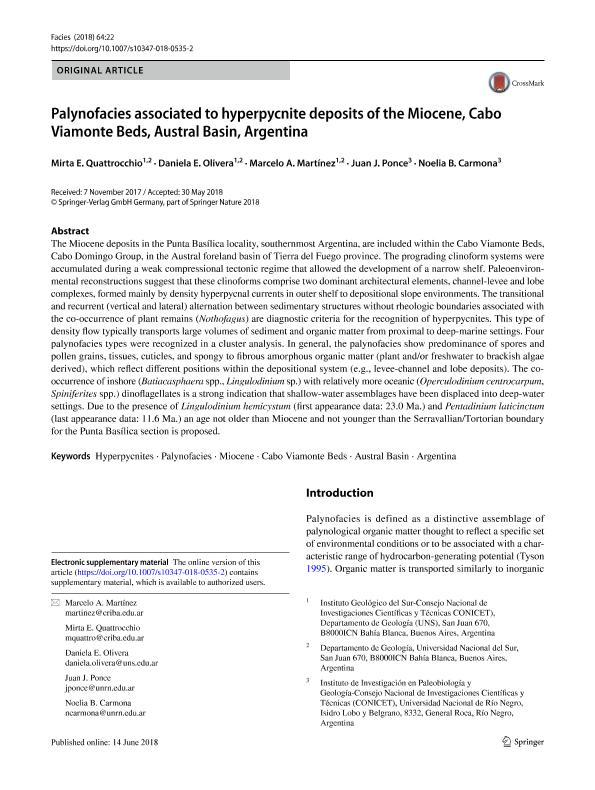Mostrar el registro sencillo del ítem
dc.contributor.author
Quattrocchio, Mirta Elena

dc.contributor.author
Olivera, Daniela Elizabeth

dc.contributor.author
Martinez, Marcelo Adrian

dc.contributor.author
Ponce, Juan Jose

dc.contributor.author
Carmona, Noelia Beatriz

dc.date.available
2019-09-19T21:47:44Z
dc.date.issued
2018-07
dc.identifier.citation
Quattrocchio, Mirta Elena; Olivera, Daniela Elizabeth; Martinez, Marcelo Adrian; Ponce, Juan Jose; Carmona, Noelia Beatriz; Palynofacies associated to hyperpycnite deposits of the Miocene, Cabo Viamonte Beds, Austral Basin, Argentina; Springer; Facies; 64; 3; 7-2018; 1-14
dc.identifier.issn
0172-9179
dc.identifier.uri
http://hdl.handle.net/11336/83948
dc.description.abstract
The Miocene deposits in the Punta Basílica locality, southernmost Argentina, are included within the Cabo Viamonte Beds, Cabo Domingo Group, in the Austral foreland basin of Tierra del Fuego province. The prograding clinoform systems were accumulated during a weak compressional tectonic regime that allowed the development of a narrow shelf. Paleoenvironmental reconstructions suggest that these clinoforms comprise two dominant architectural elements, channel-levee and lobe complexes, formed mainly by density hyperpycnal currents in outer shelf to depositional slope environments. The transitional and recurrent (vertical and lateral) alternation between sedimentary structures without rheologic boundaries associated with the co-occurrence of plant remains (Nothofagus) are diagnostic criteria for the recognition of hyperpycnites. This type of density flow typically transports large volumes of sediment and organic matter from proximal to deep-marine settings. Four palynofacies types were recognized in a cluster analysis. In general, the palynofacies show predominance of spores and pollen grains, tissues, cuticles, and spongy to fibrous amorphous organic matter (plant and/or freshwater to brackish algae derived), which reflect different positions within the depositional system (e.g., levee-channel and lobe deposits). The co-occurrence of inshore (Batiacasphaera spp., Lingulodinium sp.) with relatively more oceanic (Operculodinium centrocarpum, Spiniferites spp.) dinoflagellates is a strong indication that shallow-water assemblages have been displaced into deep-water settings. Due to the presence of Lingulodinium hemicystum (first appearance data: 23.0 Ma.) and Pentadinium laticinctum (last appearance data: 11.6 Ma.) an age not older than Miocene and not younger than the Serravallian/Tortorian boundary for the Punta Basílica section is proposed.
dc.format
application/pdf
dc.language.iso
eng
dc.publisher
Springer

dc.rights
info:eu-repo/semantics/openAccess
dc.rights.uri
https://creativecommons.org/licenses/by-nc-sa/2.5/ar/
dc.subject
Argentina
dc.subject
Austral Basin
dc.subject
Cabo Viamonte Beds
dc.subject
Hyperpycnites
dc.subject
Miocene
dc.subject
Palynofacies
dc.subject.classification
Geología

dc.subject.classification
Ciencias de la Tierra y relacionadas con el Medio Ambiente

dc.subject.classification
CIENCIAS NATURALES Y EXACTAS

dc.title
Palynofacies associated to hyperpycnite deposits of the Miocene, Cabo Viamonte Beds, Austral Basin, Argentina
dc.type
info:eu-repo/semantics/article
dc.type
info:ar-repo/semantics/artículo
dc.type
info:eu-repo/semantics/publishedVersion
dc.date.updated
2019-07-17T17:32:06Z
dc.journal.volume
64
dc.journal.number
3
dc.journal.pagination
1-14
dc.journal.pais
Alemania

dc.journal.ciudad
Berlin
dc.description.fil
Fil: Quattrocchio, Mirta Elena. Consejo Nacional de Investigaciones Científicas y Técnicas. Centro Científico Tecnológico Conicet - Bahía Blanca. Instituto Geológico del Sur. Universidad Nacional del Sur. Departamento de Geología. Instituto Geológico del Sur; Argentina
dc.description.fil
Fil: Olivera, Daniela Elizabeth. Consejo Nacional de Investigaciones Científicas y Técnicas. Centro Científico Tecnológico Conicet - Bahía Blanca. Instituto Geológico del Sur. Universidad Nacional del Sur. Departamento de Geología. Instituto Geológico del Sur; Argentina
dc.description.fil
Fil: Martinez, Marcelo Adrian. Consejo Nacional de Investigaciones Científicas y Técnicas. Centro Científico Tecnológico Conicet - Bahía Blanca. Instituto Geológico del Sur. Universidad Nacional del Sur. Departamento de Geología. Instituto Geológico del Sur; Argentina
dc.description.fil
Fil: Ponce, Juan Jose. Universidad Nacional de Río Negro. Sede Alto Valle. Instituto de Investigaciones en Paleobiología y Geología; Argentina. Consejo Nacional de Investigaciones Científicas y Técnicas; Argentina
dc.description.fil
Fil: Carmona, Noelia Beatriz. Universidad Nacional de Río Negro. Sede Alto Valle. Instituto de Investigaciones en Paleobiología y Geología; Argentina. Consejo Nacional de Investigaciones Científicas y Técnicas; Argentina
dc.journal.title
Facies

dc.relation.alternativeid
info:eu-repo/semantics/altIdentifier/url/https://link.springer.com/article/10.1007/s10347-018-0535-2
dc.relation.alternativeid
info:eu-repo/semantics/altIdentifier/doi/https://doi.org/10.1007/s10347-018-0535-2
Archivos asociados
